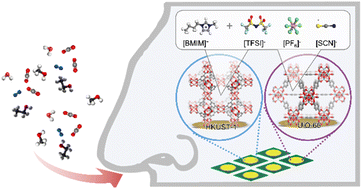A MOF-based electronic nose for carbon dioxide sensing with enhanced affinity and selectivity by ionic-liquid embedment†
Abstract
The unequivocal detection of CO2 is important in many situations, like in the living environment, plant cultivation and the conservation of cultural relics and archives. Due to their large specific surface areas and highly ordered and tunable structures, metal–organic frameworks (MOFs) have the potential to improve CO2 sensing, however, they often suffer from low CO2 affinity and selectivity. Ionic liquids (ILs) have high CO2 affinity, but their performance in sensors is hampered by their nonporous, liquid form. Here, we present a low-cost and portable CO2 sensor system based on an array of gravimetric sensors made of MOF films with embedded ILs in the pores. The array is composed of MOF films of two different structures, which are HKUST-1 and UiO-66, filled with 3 different types of ILs and 2 different pore-filling levels, resulting in an array of up to 14 different sensors. We show that the different combinations of IL and MOF result in different affinities for CO2 and other analytes. With the help of machine learning using a neural network, the sensor array was used to quantify the CO2 concentration as well as to distinguish CO2 from other gases and vapors, like nitrogen, ethanol, methanol and water, and to distinguish certain binary mixtures. While the MOF-sensor array without IL achieves only a small accuracy for determining the CO2 concentration, the IL@MOF sensor array can accurately classify the gas types (98% accuracy) in mixed gas atmospheres of unknown composition and concentration as well as can determine the CO2 gas concentration with an average error of only 2.7%. Using only MOFs with a pronounced chemical stability (like UiO-66) in the sensor array also allows the detection and identification of CO2 in a humid atmosphere. Moreover, the presented sensor system has very high sensitivity with a CO2 limit of detection below 100 ppm, which is four times smaller than the CO2 concentration in air. This work shows the unprecedented performance of the sensor arrays of MOFs with embedded ILs, referred to as IL@MOF-electronic nose (IL@MOF-e-nose), for sensing the composition and concentration of CO2 gas mixtures.



 Please wait while we load your content...
Please wait while we load your content...